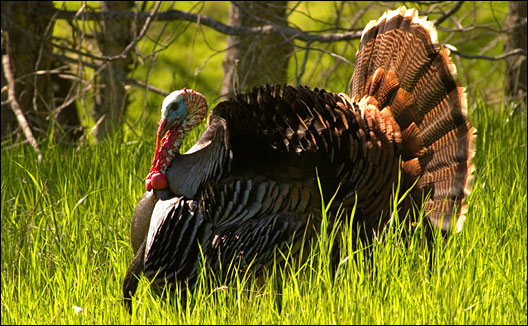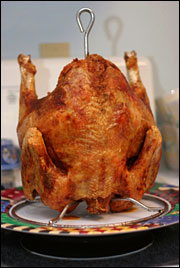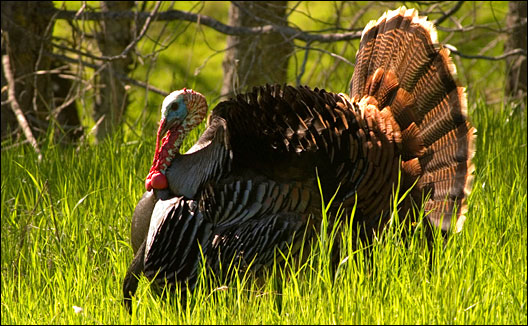
Fry ya later, alligator.
In the 11 years between the Declaration of Independence and the ratification of the Constitution, arguments raged over the future of the nascent nation. One involved the naming of a National Bird. Writing to his daughter on the subject of his choice for the symbol in 1784, Benjamin Franklin wrote, “Eagles have been found in all Countries, but the Turkey is peculiar to ours.” I’ve often wondered what effect there would have been on our national character had Mr. Franklin prevailed.
Nonetheless, thanks to America’s best holiday, the turkey has earned an honored place in our traditions at the table. Though I speak from no personal experience, I suspect that turkey is also far tastier than the handsome soaring scavenger that is our national bird.
Each year around this time, home cooks across the country get uptight about their Thanksgiving meal, fretting that they’ll over- (or under-) cook the main course. I’ll help you with that in a moment, but first I should point out that as with any cooking, the better the ingredients you begin with, the better the dish you end up with.
Bowling with Butterballs
The commercially available turkey which some of us used to bowl down the aisles of local groceries at 3 a.m. back in college is useful for very little else. It is flavorless. It is laden with hormones and antibiotics, and leads a tortured, stupid, flightless, and sexless existence in a pen somewhere in Arkansas. True turkeys, contrary to popular belief, are not stupid, can fly, and are permitted to live happy turkey lives out in the open. One of many resources for such magnificent birds is Local Harvest.
Are they more expensive? Yes. But this 14-pound turkey from K&M farms will, at $75, feed a family of 10, so that means $7.50 per person. Surely worth it for the holidays, at least for those with the means. For those who are on tighter budgets, you could of course get a much cheaper turkey at the grocery store. But consider cutting corners somewhere else instead of on the centerpiece of the holiday meal.
Once you’ve chosen your turkey, what to do with it? Sure, cooking a 14-pound bird presents challenges, but it’s eminently doable. Roasting is, of course, the most common method, and can deliver a quite-tasty bird if done well, which is not too challenging. The main thing to remember is not to overcook it, and the way to monitor that is with a meat thermometer. Roast the bird at 350 F, plan for about 20 minutes per pound, and baste and rotate frequently. When it reaches 161 F, remove and cover loosely with foil or a lid, and let rest for about twenty minutes before carving. This redistributes the juices.
For added flavor and juiciness, consider brining the bird. To do this, you need a bucket big enough (and clean enough!) for the bird, and refrigeration space big enough for the bucket. This time of year, my garage is often just the right temperature (it needs to be between 34 and 42 to be safe). For the brine, mix 1/2 cup of kosher salt and 1/4 cup of brown sugar per gallon of ice-cold water, and make enough of this ratio to totally immerse your bird in the bucket. Brine this way for about 8 hours, inverting the bird once halfway through, and rinse well before roasting as above. You’ll be pleased with the result.
I got an email last week asking for my method for deep-frying a turkey, so here that is, but first a note of caution: Do not — under any circumstances — do this inside your home, in your garage, or on your patio or deck. Do this on pavement, well clear of obstacles and flammable things. Nothing spoils the mood of the holidays like a house fire.
Deep-Fried Turkey
Equipment Needed:
A King Kooker or other large outdoor stove
Large pot (size depends on the size of your bird)
Candy or deep-fat thermometer
Turkey-frying rack (available at most camping stores)
A long, strong dowel or broomstick
An instant-read meat thermometer (for determining doneness)
Ingredients:
1 heritage turkey, any size
30 pounds (yep, 30 pounds — or as much as needed for smaller birds) of lard, though peanut oil works. Heck, live a little — nothing wrong with lard.
2 tablespoons each of salt, minced garlic, and paprika
1 tablespoon cracked black pepper
Olive oil as needed
Procedure:
Place the lard in the pot over a medium flame on the cooker. Once again, I highly recommend doing this outdoors, on the lawn. This way if there is an accident, you end up with a scorched spot in your lawn and a dirty turkey instead of a burned-down house and a ruined holiday.

While the lard is heating up to 375 F, and being closely monitored and protected from children and pets, wash the bird in cool water and pat dry, inside and out. Mix the spices with just enough oil to make a paste. Rub this marinade all over the bird, inside and out, then place the bird on the rack or wire by running through the cavity from the neck end to the open end.
Allow the bird to marinate, covered, while the lard continues to heat. This may take an hour or two since you want to bring it up to temperature gradually (it’s safer that way).
Once the oil is at 375 degrees, hang the wire from a long, strong dowel and have someone help you gradually lower the bird into the oil. Most of the accidents folks have had doing this are a result of putting the bird in the fat too fast, causing it to boil over and ignite. So, gradually lower the bird into the fat, and hook your wire on the edge of the pot.
Allow the turkey to cook for 4 minutes per pound. At the end of that time, gradually lift the bird from the lard using the dowel. Have someone standing by with a large casserole dish to catch the bird as it comes out of the oil. Check the internal temperature with the meat thermometer. When it reaches 165 degrees, carefully bring it inside (don’t forget to turn off the cooker, unless you have other fish to fry).
Cover the turkey with foil and allow to rest for 20-30 minutes, then carve as usual and enjoy.



